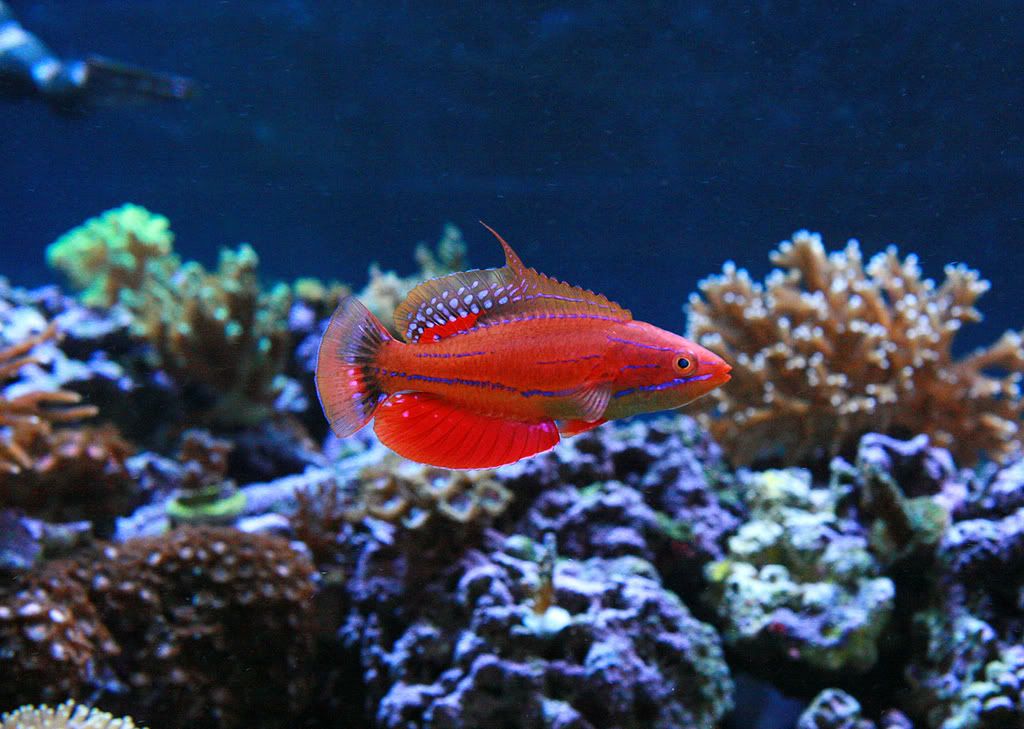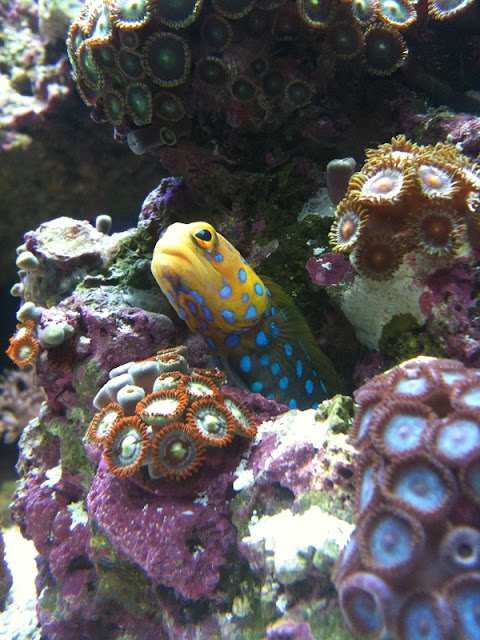I never posted about this guy even though I got him in April... a Blue Spotted Jawfish (Opistognathus rosenblatti). I thought he deserved his own long post with a video (which I did post) and explanation of his habits and behaviors (which I didn't) but it never manifested. The brief couple of months he was in my tank were very enjoyable for all and I miss his antics, as annoying as they sometimes were. It turns out brain corals really don't appreciate being repeatedly covered in sand.
These fish are known to be jumpers and he eventually managed to find an opening in my makeshift tank cover (for the past few months I have not been using the stock Oceanic BC29 hood, which I'll cover later in this post). He took an ill-fated leap and, as we say in the hobby, went carpet surfing. Rest in peace little buddy.
Despite being one of the most expensive fish I've ever bought, I do intend to keep another when I have (much) more space and a suitable environment in some future tank. It is one of the most interesting, beautiful, and personable fish I've seen yet. If you're interested in keeping one, just be prepared to have your sand constantly rearranged to his or her liking.
My two Ocellaris clowns, the first fish I brought home when my tank was first finishing it's initial cycle, had grown to twice their original size and were becoming quite aggressive. I suppose it's hard to give everyone their own space in a 29 gallon cube. Longer tanks are probably better suited to the creation of distinct territory or at least breaking up the line of sight.
Even though they couldn't intimidate the Jawfish due to his size, both clowns would try to threaten him whenever he got close to the torch coral (their surrogate anemone). They also wouldn't let the female McCosker's flasher wrasse out of her corner. This stress and harassment caused her to frequently leap out of the water... eventually she made it over the false wall (as I mentioned in a previous post) and was no more. They even intimidated the male McCosker's, but he usually held his own. The female clown attacked and bit my hand whenever I had it in the tank doing maintenance. They weren't even fully grown yet.
Thus came the decision to sell them as a pair... and I did. hopefully right now they are living happily in someone else's fish tank, biting someone else's hand, being vicious hellions towards their tankmates, etc.
After all was said and done, I was left with a lone male McCosker's flasher wrasse. The difference in his behavior once the tank was his and his alone was profound... he was always comfortably out and about, swimming in the front of the tank, being curious, and would follow me around from one side of the room to the other. I fed the tank far less and was subsequently able to keep my water quality higher. I decided at that point that having one happy fish was better than pushing the limits of space and filtration for the sake of variety.
Then I changed my mind and thought I would keep a species tank of one male McCosker's with a harem of a few (2-3) females. I located and purchased said "females", but they turned out to be "males". Whoops. Three males in a 29g is two too many, to say the least. Paracheilinus mccoskeri are protogynous hermaphrodites - meaning that they start out as female and the dominant female changes into a male if there is none present. Unfortunately for my trio of dudes, their remarkable transformation from this...
...into this...
 |
| (This is not my photo! Posted by Rickyrooz1 on the ReefCentral.com forums) |
...is irreversible. Once they embark on the journey to becoming male, their bodies can not naturally revert to female. According to a crew member from WWM, the transformation from male to females has, however, been induced via hormones in a lab environment.
In any case that was sort of the end of my McCosker's species-tank pipe dream. Having a single male McCosker's isn't really worth it because the main draw of these fish is their social interaction and the male displaying for females. Without females, males quickly lose their brilliant coloration and become a rather drab. Furthermore, finding a reliable source of female McCosker's is pretty difficult. My LFS had not seen one for several months. I decided that I would remove all three males and sell them, leaving my tank sans-fish for the time being
As anyone who has ever kept fish in a reef can attest, capturing anything with a net can be destructive and frustrating. For me it involved removing a lot of rock and live coral, and about half an hour of precision net maneuvering (it's all in the wrist). After all was said and done, my tank was in a state of chaos:
I waved goodbye to my fish and his two reluctant, unlikely companions, and sold them to my LFS where they would hopefully each find a more suitable (and separate) home. Here is my last photo of them, looking quite glum, as we parted ways:
Sometime during all of this activity, I moved to a new apartment unit. The whole moving process probably deserves its own post but will not get one, so I'll just say that it was a pain in the ass... but not so much that I can't do it every time I change living space, an inevitability in apartment living. This was not only a relatively small (and therefore easy) tank to move, but I was only moving to a new unit in the same building so there were no cars or long distances involved, which really complicate matters. For me it was a simple process:
- Have 15-20 gallons of water pre-mixed and pre-warmed at the destination, because you'll need it (part of this process involves a water change). Also have several towels you don't care about on the floor and at the ready.
- Drain roughly 15 gallons out of the tank, put it in clean 5-gal buckets.
- Remove the large loose live rock (with attached coral and all). Place it safely in the buckets of water removed from the tank, making sure the coral will not be damaged or broken while moving.
- Capture all livestock and add it to one of these buckets.
- Remove the rest of the water, down to the sand, and discard.
- Move livestock to the new unit.
- Move tank and stand to the new unit.
- Refill the tank using mostly new water; reintroduce the live rock and coral that was removed.
- Reconnect all electrical equipment.
- Reintroduce livestock.
- Monitor temperature, water chemistry (especially nitrates)... this continues for a couple of weeks after the move.
- Clean up the mess.
- Admire your tank in it's new location.
In that last picture you might notice the Tek-Light over the tank instead of a BioCube hood. A couple of months ago one of my stock ballasts suddenly died, and the one working bulb was insufficient to keep the corals healthy. Oceanic (aka Central-Aquatics) was quite good about sending me a replacement (once I sent them a copy of my receipt), but as soon as I replaced the first failed ballast, the other one died. How annoying. In subsequent troubleshooting I found out that there was also some sort of wiring problem within the hood itself which left me with yet another dead ballasts (a bad connection and/or short, possibly?).
I was also going to be due for bulb replacement to the tune of ~$45. That's a lot of bones to cough up when there are do-it-yourself alternatives/upgrades. Given the frustrating situation with the stock hood, I began my planning.
In the interim two months I had been using a 4-bulb 96W PC bulb Sunlight Supply Tek Light with 3 actinics and 1 white 10K bulb (see above), and now am using a 75W Metal Halide 12K bulb in a Current USA Sunpod ... both of which were graciously lent to me by a friend... neither of which are permanent solutions. They're just a temporary measure to keep my coral alive and happy while I plan the permanent solution. I did have to repair the Sunpod before it worked:
I don't really want to deal with any more failed ballasts, Oceanic customer service (polite and helpful as they may be), continual replacement bulbs, or mediocre PC lighting. I want to double or triple the amount of photosynthetically viable light in the tank to support demanding coral. I also want to go back to a tight-fitting lid to limit evaporation and a manufactured look. The only real option, then, is a high-power LED retrofit into the stock hood. This is a pretty expensive and involved endeavor and will get its own write-up when I'm done, but it's underway. I'm excited!
For now the tank is empty and a little bit boring. I miss having a single fish in there owning the whole place as if it was a mansion and giving me the stink eye every time I walk by without feeding it. I won't be able to resist getting one for much longer, so a lot of thought is going into what is a suitable inhabitant. It has to be a fish that doesn't get too big, won't eat coral, doesn't hide very much, and doesn't prefer company (like Anthias do). More to come.





